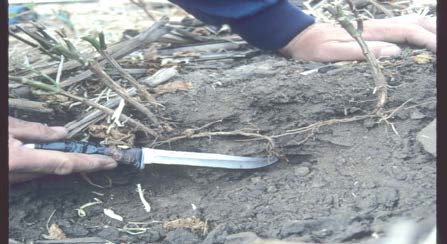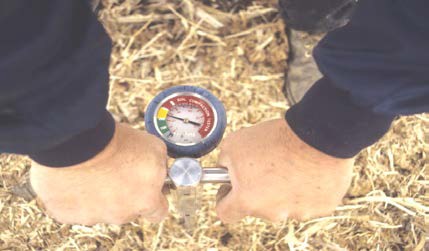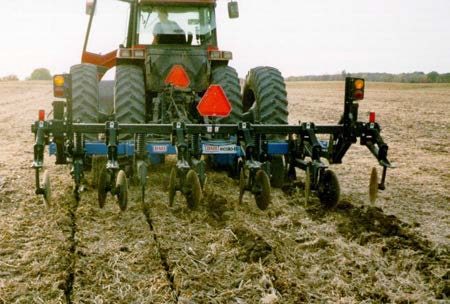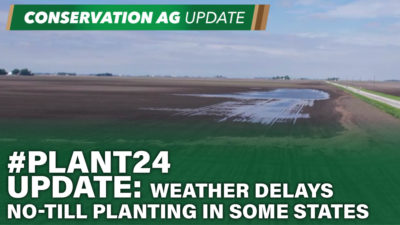What is Soil Compaction?
Soil compaction is the increase in bulk density and decrease in soil porosity caused by heavy loads when too wet. Soil compaction decreases water infiltration, increases runoff, and restricts root growth. Soil compaction that impedes crop growth can occur at different depths in the soil profile. Crop yield reduction due to soil compaction depends on the degree of stress the plant experiences during the growing season (Harrigan, 1992).
Surface compaction is described in research literature as being in the top 12 inches of the soil profile. (Voorhees, 1987). Surface compaction can be managed and does not persist for very long in the soil. However, the Cornell Soil Health Test uses 0-6 inches to measure surface compaction with a penetrometer. (Gugino, et.al. 2009). Surface compaction is usually more manageable and does not persist very long in the soil. (Jeschke, et al 2019)
Subsoil compaction occurs deeper than 12-inches in the soil profile. Compaction in the subsoil is a function of the total equipment axle load of farm equipment when used on the field. However, the Cornll Soil Health Test uses 6-18 inches to measure subsoil compaction. For surface and subsurface compaction, the Cornell SHT uses 300 PSI with a soil penetrometer as the point where root growth becomes limited when the soil AWC is at Field Capacity. Roots can not penetrate the soil with penetrometer readings above 300 PSI. (Gugino et. al. 2009).
“Soil compaction is one of the most serious forms of soil degradation caused by ag production.” (Jeschke 2019)
There are two types of visual and measured symptoms of soil compaction: soil symptoms and plant symptoms.
Soil symptoms include: (Robertson, et al 1976)
- Standing surface water (frog ponds) even if tiled
- Increased bulk density (clods and crusting)
- Less porosity (no air & slower infiltration)
- Wetter soils (slow to dry)
- “Dead,” soil (light color and lacks organic matter)
- Soil structure is platy (poor) verses good soil structure that is granular or blocky
- Tillage pan (horizontal compaction) below soil surface. (plow pans) or visual dense layers
- Bald clay knobs on hill tops and side slopes (poor plant stands & barren slopes & high bulk density).
- Excessive soil erosion, runoff, or gullies
- Uneven planting depth due to soil clods (results in poor plant stands or uneven emergence.)
- Less resilient soil that supplies less water and nutrients to the crop.
- Clods, lumps, and lifeless soil
- Slow drying that prevents field entry
- Surface crusting
Plant response to compaction depends on soil conditions at the time compaction occurs and the climatic conditions during the next growing season.
Plant symptoms include: (Robertson et al 1976)
- Uneven stand (slow or failed crop emergence)
- Stunted growth (small plants)
- Discoloring (yellow-and purple plants)
- Lack of a stand and roots (row skips, no brace roots on plants)
- Shallow, flattened, twisted, knotted roots (root balls, horizontal, or "J" roots along soil pans)
- Enhanced drought stress symptoms (pineapple and whorled corn)
- Reduced yield
What Causes Soil Compaction?
Heavy wheel traffic and equipment load on wet soils is the main cause of soil compaction. About eighty percent of soil compaction is caused by the first trip over the field (Voorhees, 1987). Soil moisture is the most important soil factor influencing the risk of soil compaction.
Other causes include:
- Planting and tilling soils that are too wet (pressure to plant earlier).
- Bigger equipment with wider tires and heavier axle loads
- Excessive tillage for seedbed preparation
- Harvesting when the soil is too wet
- Rutting the soil from hauling manure or spreading fertilizer
- Depleting of soil organic matter by intensive tillage or crop rotations without legumes
- Intensive tillage that destroys soil structure
- Some natural soil properties
Compaction Effects on Soil Properties: Surface Verses Subsurface Compaction
Surface compaction of topsoil is determined by contact pressure, subsoil compaction is determined by axle load. Research shows 80-90% of the wheel traffic occurs on the first pass. Using fewer trips and controlled traffic patterns can reduce surface compaction.
Axle load is the total weight carried by one axle expressed in lbs. kg. or tons.
- Equipment axle loads of 5 tons will create surface compaction to about 12” deep.
- Normal tilling and planting operations with eight row or greater equipment will exceed the 5 tons axle load.
- Normal tilling and planting operations with six-row equipment usually does not exceed the
- Normal tilling and planting operations with six-row equipment usually does not exceed the 5 tons axle load.
- Axle loads greater than 10 ton create subsurface compaction below 12 inches deep.
- Subsurface compaction below 12 inches reduces effectiveness of tile drainage systems causing ponding and slow soil drainage, drying and warming.
- Harvest equipment has the greatest potential for causing subsurface compaction. This includes grain carts and harvest trucks.
|
Equipment Axle Loads EQUIPMENT* |
AXLE LOAD (tons) |
|
Grain Cart 1200 bu full 1 axle |
35-40 |
|
Combine 12-Row header full |
24 |
|
Grain Cart (720 Bu) 1 axle full |
22 |
|
Class 9 combine 590 HP, 360 bu |
20 |
|
4WD Tractor 530HP Front axle |
18 |
|
Slurry Tanker 7200 gal |
17-18 |
|
Terra Gator rear axle |
12-18 |
|
4 WD Tractor |
12.7 |
|
Slurry Tanker 4200 gal |
10-12 |
|
MFWD Tractor |
7.7 |
*Caterpillar, 1996. Pioneer, 2019.
Persistence of Surface Compaction
- Freezing and thawing has little effect of eliminating deep subsoil compaction (below 12 inches) and it can persist over winter.
- Mechanical tillage, such as moldboard plowing and chisel plowing, can reduce surface compaction.
- Horizontal tillage equipment may create deeper surface soil compaction (tillage hardpan) than disk blades and sweep blades.
|
EQUIPMENT* |
Weight (tons) |
|
2018 Case 9240 Combine full 16 row corn head |
39 |
|
1998 Case 2388 Combine full 8 row corn head |
22 |
|
1998 Case 2388 Combine Empty |
14 |
|
2014-2017 Case IH Magnum 380 |
16 |
|
2003-2006 Case IH Magnum MX 285 |
11 |
|
1987-1993 Case IH Magnum 7130 |
9 |
|
1976-1981 IH 1086 |
6 |
* Pioneer, 2019
Plant Response to Surface Compaction
Soil research shows that a soil bulk density of 1.3 g/cc is optimum for crop production. Above or below this level crop yields may be less. However, optimum yields depend on soil and plant characteristics, and growing season climatic conditions (Robertson et. el., 1976). See table 1, page 5, for guidance on bulk density causing soil compaction by soil type.
Compacted soils can’t supply nutrients or water to the crop, rooting depth is limited meaning less water is available for plant uptake.
Compaction reduces infiltration or the rate water moving downward thru the soil profile decreasing plant available water. This leads to increased runoff with a greater risk of erosion. Soils that are saturated with water reduce the amount of oxygen for proper plant root growth. Saturated soils are slow to drain, warm up more slowly and take longer to dry out between rain events so fields are suitable for field work. Topsoil compaction is caused by animal or wheel traffic when too wet. Topsoil compaction occurs from the surface down thru the normal tillage zone.
Effect of Climate on Surface Soil Compaction and Crop Yield Response (0-12" deep)
Crops can tolerate a higher compacted soil during dry conditions than during wet conditions.
For example, soil compaction research in Minnesota on soybeans found that when May-August rainfall exceeded 14 inches, soybean yields were significantly decreased in compacted soil. However, if May-August rainfall was less than 14 inches, soybean yields were drastically increased by the presence of inter-row wheel traffic, (Voorhees, 1987).
Research Results from Minnesota Using Corn Yield to Predict the Effect of Climate on Subsurface Soil Compaction. (Greater than 12" deep)
- On soils with 10% clay or less compacted when wet using axle loads of 10-20 tons, corn planted the following year showed only a slight yield reduction. On these soils, subsoil compaction may last only one year (Voorhees, 1987). In Michigan, soils with 10% clay or less are classified as MSU Soil Management Group 5.0 or 4.0 soils.
- On soils with greater than 30-39% clay compacted when wet using axle loads of 10-20 tons, it took 3-5 years of normal freezing, thawing, wetting and drying to bring corn yields back to normal (Voorhees 1987). Soils with 30- 39% clay are classified as MSU Soil Management Group 1.5 soils.
- On soils with 40-70% clay and compacted using axle loads for 10-20 tons, corn yield reductions occurred for 7 years regardless of annual freezing and thawing. Research in England on similar soils showed that subsoiling 14" deep showed no effect on corn yield. In fact, deep tilling of such soils when wet can increase bulk density and create a deeper tillage pan. (Voorhees 1987)! Soils with 40-70% clay are classified as MSU Soil Management Group 1.0 or 0.
- Subsurface (Deep) Compaction (greater than 12 inches) is hard to eliminate and may impact growth for several years depending on the amount of clay in the subsoil.
Effects of Soil Texture
Soil texture influences how a given crop responds to the degree of soil compaction.
- Soil compaction increases on poorly drained or wet, fine textured soil with each additional farm equipment pass.
- As the soil texture becomes finer and wetter, crop yields become more sensitive to compaction.
What are the Corrections for Soil Compaction?
Tire Contact pressure is the primary factor determining topsoil compaction or surface compaction.
- Reducing contact pressure will reduce compaction in the topsoil.
- Lowering tire pressure or using wider tires can reduce contact pressure. And using low- pressure radial tires can help reduce topsoil compaction.
- Increasing the surface area of contact by using wider tires, duals or tracks can reduce topsoil compaction.
- Grain trucks and other vehicles with high axle loads and high-pressure road tires can cause severe topsoil compaction.
- Lower tire pressure can help reduce soil compaction.
- New lower pressure ag tires are available.
First, identify the depth of the soil compaction layer.
According to Dr. Gary C. Steinhardt, Purdue University, "to minimize or correct soil compaction you need to …identify the nature and extent of the problem in the field,” (Steinhardt 1985).
There are two methods to determine the presence of soil compaction and depth of the compaction layer or tillage pan. These procedures work best when soil is moist to the touch below the surface.
One way is to dig a hole and observe the soil structure for compacted, platy soil layers.
Dig a hole two feet deep and look for wormholes and old root channels. With a strong bladed knife stuck 3- inches deep in the sidewall near the bottom of the hole, slowly pull the knife up until it is nearly impossible to lift higher. Your hand will feel resistance. This is the bottom of a compaction pan. Determine the depth of the pan by following the same procedure from the soil surface.
A second way is to use a soil penetrometer. This is thin rod with a spring-loaded gage that records the pressure needed to penetrate the soil. Push the penetrometer slowly into the soil until it reads 300 PSI or more. Stop and measure the depth. Then push the penetrometer deeper until it reads less than 300 PSI. Note the depth. This method determines the width and depth of soil compaction and works best when soil moisture is at Field Capacity.
Determine Soil Moisture Conditions — Plastic Limit
Plastic limit is the soil moisture content at which soil material can be deformed without rupture or soil particles start to slide over each other. At or above (wetter than) the plastic limit significant soil compaction will occur. Below (drier than) the plastic limit minimal compaction will occur.
“Soils with AWC at or above field capacity have the greatest potential for compaction. Water acts as a lubricant between soil particles that allows soil to be pushed together. As more air space is replaced with water, the potential for compaction increases up to a maximum point referred to as the “plastic limit.” At soil saturation levels above the plastic limit the compaction potential of the topsoil declines since water can’t be compressed. This results in the compaction force being directly transferred to the subsoil, increasing the risk of subsoil compaction.” (Duiker, 1994).
(Hand Rolling Method) to determine plastic limit.
- Take about 1 tablespoon of soil, enough soil to make a 1/8 in. (3 mm) rod (rope, thread, wire) between fingers and palms with little or no rod extending outside of fingers or palms.
- Squeeze and form the soil into an ellipsoidal-shape mass.
-
Roll this mass between the fingers or palms with just enough pressure to roll the mass into a rod of uniform diameter along its length. Roll out between 40 and 45 strokes per 30 seconds, counting a stroke as one back and forth motion. The sample must be rolled into the 1/8 in. (3 mm) rod in about 30 seconds. If more time is taken, some soil water will be absorbed by fingers and palms.
If the rod crumbles under the pressure required for rolling and the soil cannot be rolled into a 1/8 in. (3 mm) rod, the soil is drier than the plastic limit. - If the soil can be rolled into a 1/8 in. (3 mm) rod, the soil is wetter than the plastic limit.
Ribbon Test to Determine Plastic Limit
“the ribbon test involves digging soil to four inches deep and grasping a hand full of soil, squeeze it between the thumb and forefinger. If the soil forms a “ribbon” when squeezed, the soil is in condition for soil compaction to occur”. (Duiker, 1994).
Determination of the plastic limit is independent of soil texture. If the soil is too granular to form a rod or a ribbon even when very moist, then it is not very susceptible to compaction and smearing.
Using Deep Tillage (Vertical Tillage)
Determine the Plastic Limit of your soil using one of the above procedures. Other observations or rules of thumb: If the soil makes a ball in your hand at the depth of tillage it's too wet to till. Or if shinny ribbons of soil peel off the equipment shanks as tilled, then the soil is too wet, or tillage is too deep.
Once the depth and extent of the compacted zone is determined, there are several options for removing this yield robbing soil factor.
Use a subsoiler or deep till with slots if the compacted layer is deeper than 12 inches. Set either implement to run about 1/2 to 1 inch below the bottom of the compacted layer.
Sow a deep-rooted crop like alfalfa, sweet clover or tillage radish cover crop to break up the hard pan.
Deep Tillage with a Subsoiler
For farmers that till, subsoil at least 12 inches deep when the soil is dry enough to shatter the hard pan. If the soil moisture is correct for every inch of subsoil shank depth, the soil should shatter out at a 45-degree angle or two inches per inch of depth (2:1). A lesser angle of shatter might indicate the soil is too wet to subsoil and may create a new tillage pan at the new deep tillage depth. In theory, dry soil breaks up and shatters much better then wetter, plastic soils (Harrigan, 1992).
Avoid any secondary tillage operations in the fall after sub soiling. Dr. Gary Steinhart, Purdue University, says 80% of compaction is caused by the first trip over the field. If the soil is compacted by tillage and wheel traffic soon after subsoiling, the soil structure problem may be more severe than before the initial deep tillage. Staying out of the field just one more day in the spring could reduce compaction (Steinhart, 1979).
Deep Tillage with Vertical Slot Tillage or Zone Tillage
Another option to correct compaction before No-Till is to deep zone-till. In Don Schiefer’s book, Tillage in Transition, deep compaction from rutting or tilling soils that are too wet, is corrected by locating the depth of the tillage hardpan, determining its thickness, and tilling a narrow slot through the pan when the subsoil is damp, i.e. (damp: soil sticks together, but easily breaks apart with pressure).
Schriefer recommends a zone builder to aerate the soil, improve drainage and strengthen soil structure. Zone tillage at the correct soil moisture will smear the subsoil and compact each side of the shank so there is a permanent crack in the subsoil. More recently, some agronomists refer to this tillage as vertical tillage. It is important to control traffic in vertical tillage to prevent wheel track axle loads from closing the subsoil slot, i.e. do not drive over the slots, if possible.
It is also important to plant the crop near this slot to allow the crop roots to penetrate below the compacted soil tillage pan. The next crop can then follow the old root channels. This will help insure that the subsoil zone remains open, so roots can penetrate deeper for moisture and nutrients while remaining in an air-filled environment.
With deep tillage, soil aeration, and controlled traffic:
- The roots replace the slots and keep the root channels and worm holes open for improved drainage into the subsoil.
- The narrow slots serve as future expansion zones for freezing and thawing forces to keep the zone- tilled slot open.
- Microbial soil activity is improved due to aeration and a carbon food source (deep roots).
Two years of deep slot tillage, followed by driving on soils only when it’s dry or the right moisture for tillage, should prevent soil compaction from occurring.
Deep Slots ahead of soybeans on low wet ground without tile drainage “provided improved drainage compared to No-Till for soybean growth during the extraordinary wet years, such as the one encountered in 2004.” As a result, after 2 flooding events in the spring, the seed germination and plant stand at maturity was considerably higher on slots compared to the no till plot (Dierberger, 2005).

Navy bean root parallel to hard pan indicates depth of surface soil Compaction. Source: NRCS Grigar Tuscola County, MI
Soil Compaction Prevention Methods Include:
- Providing adequate drainage
- Using legumes and small grains in rotations
- Staying off wet soils.
- Farming with longer crop rotations or with more high residue crops in rotation
- Running combine wheels on harvest rows
- Alternating row centers in No-Till corn allows the wheels to be supported on the decaying row.
- Reducing wheel traffic with No-Till, zone till, strip till, ridge till or vertical till.
- Combining low axle loads with low tire pressure to achieve the largest reduction in soil compaction.
- Adding organic material (manure) to stimulate soil life, especially in low organic matter soils. Soils high in organic matter generally have better structure and resist soil compaction better than low OM soils.
- Substituting lighter equipment for heavier, whenever possible.
- Avoiding use of a disk.
- Avoiding tilling soil when it's too wet.
- Reducing secondary tillage.
- Reducing surface pressure with wider tires or duals.
- Using high flotation rubber tracked equipment on planters and sprayers
- Tracks for combines and grain carts will not eliminate the risk of subsoil compaction on heavy axle loads.
- Controlled traffic at harvest try to follow the combine wheel tracks with the grain cart.
- Keep Semi Grain trucks on the field edge or road.
- Narrow strip cropping
- Using a controlled traffic system
- Adopt Long Term No-Till to maintain an active food web and improve soil structure.

Navy bean root parallel to hard pan indicates depth of surface soil Compaction. Source: NRCS Grigar Tuscola County, MI
Table 1: Bulk Density (g/cc) by soil texture that root restriction can occur.
| Soil Texture Density | Bulk (g/cc) |
| Coarse, medium, and fine sand and loamy sand other than loamy fine sand | 1.8 |
| Very fine sand, loamy very fine sand | 1.77 |
| Sandy loam | 1.75 |
| Loam, Sandy clay loam | 1.70 |
| Clay Loam | 1.65 |
| Sandy clay | 1.60 |
| Silt, silt loam | 1.55 |
| Silty clay loam | 1.50 |
| Silty clay | 1.45 |
| Clay | 1.4 |
| Source: USDA NRCS Soil Quality Resource Concerns: Compaction.1996. Soil Quality Information Sheet. | |
Soil Compaction is Really a Biological Problem.
Soil compaction is a result of macro-aggregate depletion by tillage. Intense tillage destroys water stable aggregates. Heavy equipment operated on wet soil packs it.
Living plants with active root systems along with mycorrhizal hyphae and their biotic glue can significantly reduce soil compaction. Long term No-Till favors a fungal dominated soil where hyphae and glomalin are the “biotic glue” that holds water stable aggregates together. Excessive tillage breaks down water stable aggregates and allows bacteria access to glomalin stored inside. Soil becomes bacterial dominated and more prone to soil compaction under continuous tillage. Soil becomes “unglued” or loses soil tilth. Heavy equipment drove on wet soil where water stable aggregates have been destroyed by tillage, rainfall impact or wind erosion abrasion leads to surface and subsurface soil compaction, crusting, rutting, ponding and excessive runoff. Hard, sun baked, cloddy soil is the new seed bed devoid of an active food web. (Hoorman, et. al. 2011.) Some folks call it DIRT. (Montgomery, D. 2007.)
Future Methods to Control Soil Compaction.
Tramlines: (controlled traffic) like European farms use in small grain production. Autonomous machines: lighter computer-controlled tractors that work 24/7 when soil conditions are ideal.
Final thought: "A dry year will scare you. A wet year will starve you." Anonymous MI Farmer.
Prepared by: Jerry Grigar, NRCS MI State Agronomist, Dr. Jerry Lemunyon, NRCS Conservation Agronomist, Fort Worth, TX. Dr. Del Mokma, MSU Crop and Soil Sciences, E. Lansing, MI
References
Caterpillar, Inc. 1996, Managing Soil Compaction.
Duiker, S. 2002. Diagnosing soil compaction using a penetrometer. Penn State Univ. Ext.
Dierberger, B., G. Silva, 2005. Increasing Soybean Profitability with Innovative Tillage, 2004 On Farm Research and Demonstration bulletin, MSUE AOE Field Crop Team & Michigan Ag Experiment Station
Elanco Products Inc., Don't let Soil Compaction Squeeze Your Profits. EA-4024.
Gugino, et al, 2009. Cornell Soil Health Assessment Manual, Edition 2.0. Cornell University, Geneva NY.
Harrigan, T., J. Grigar, R. Hall. 1992. Planning for Conservation Compliance, Section IV. Tillage. Michigan State University, E. Lansing, MI.
Hoorman, J. J., et al, 2011. The Biology of Soil Compaction. Science. Pg. 583-587
Jeschke, M., N. Lutt. 2019. Soil Compaction in Agricultural Production. Pioneer Research Summary.
Marking, S. 1994. Ten Ways to Whip Soil Compaction, working wet fields is the biggest mistake, Soybean Digest, Mid-March.
Montgomery D. 2007. DIRT. The Erosion of Civilizations.
Robertson, L. S., Erickson, A.E., Christenson, D.R., 1976. R. R. 294. Visual Symptoms Causes and Remedies of Bad Soil Structure. Michigan State University, E. Lansing, MI.
Schriefer, D.L., 1992. Tillage in Transition. Advanced Agriculture Inc., Demotte, IN.
Soil Quality Institute 1996. Soil Quality Information Sheet. Soil Quality Resource Concerns: Compaction. USDA Natural Resources Conservation Service.
Steinhardt, G.C., J.V. Mannering, D.R. Griffith, H.M. Galloway. 1979. A.Y.-221. Soil Compaction in Indiana. Purdue University. W. Lafayette, IN
Voorhees, W.B., and J.G. Hendrick. 1977. Soil Compaction our Newest Natural Resource, Crops and Soils Magazine. American Society of Agronomy, Madison, WI.
Voorhees, W.B. 1987. Influence of Compaction on Plant Growth. In Proceedings. Conservation Tillage on Wet Soils Conference, Iowa and Minnesota Soil Conservation Society of America.







Post a comment
Report Abusive Comment